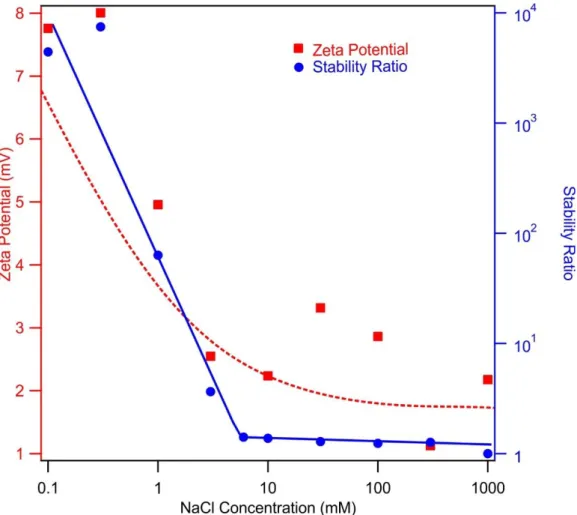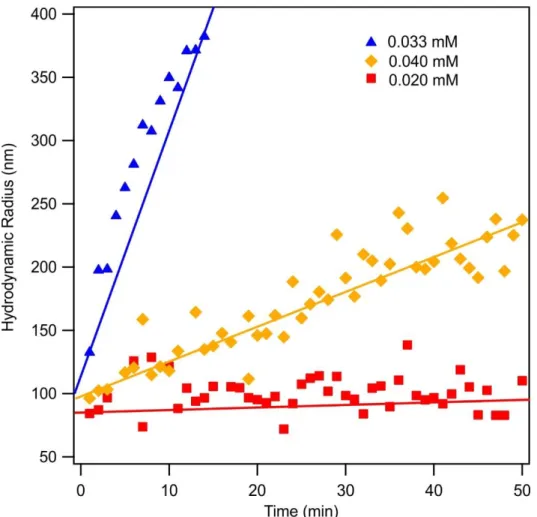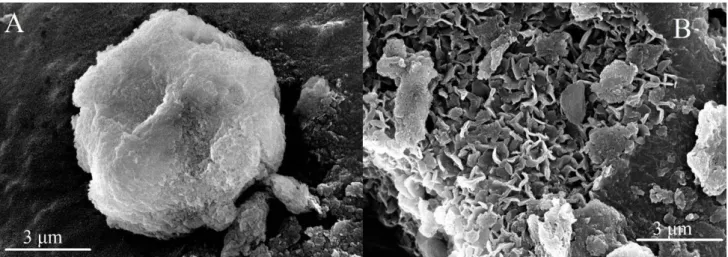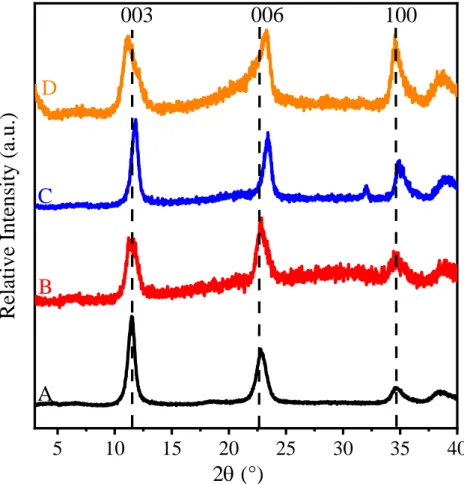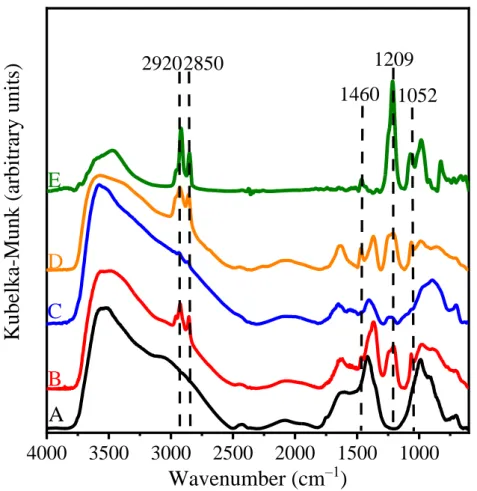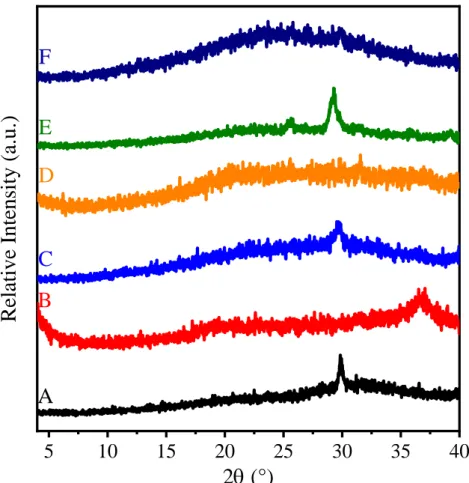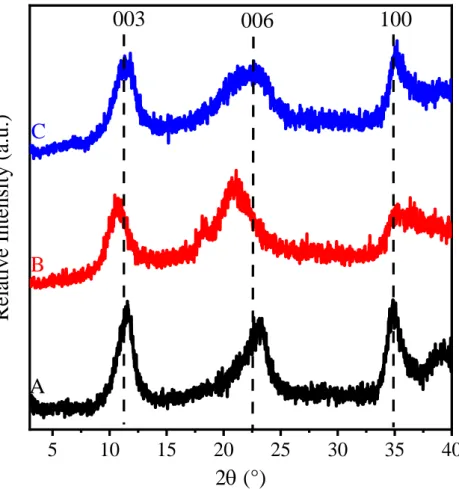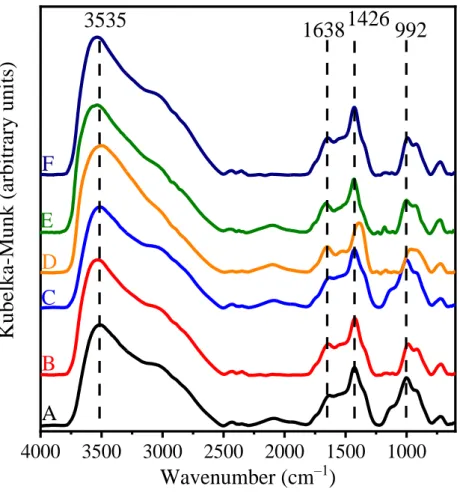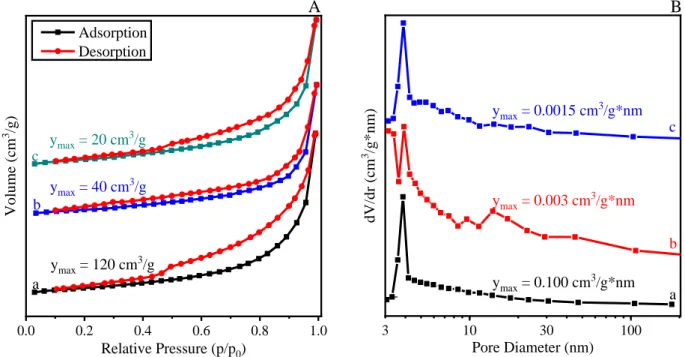S1
Supporting Information
A Colloid Chemistry Route for the Preparation of Hierarchically Ordered Mesoporous Layered Double Hydroxides Using Surfactants as Sacrificial Templates
Gábor Varga,† Zoltán Somosi,§ Zoltán Kónya,#,║ Ákos Kukovecz,║ István Pálinkó,† and Istvan Szilagyi§,*
†Materials and Solution Structure Research Group, Department of Organic Chemistry, University of Szeged, H-6720 Szeged, Hungary
§MTA-SZTE Lendület Biocolloids Research Group, Interdisciplinary Excellence Center, Department of Physical Chemistry and Materials Science, University of Szeged, H-6720 Szeged, Hungary
#MTA-SZTE Reaction Kinetics and Surface Chemistry Research Group, H-6720 Szeged, Hungary
║Department of Applied and Environmental Chemistry, University of Szeged, H-6720 Szeged, Hungary
Materials. Magnesium(II) nitrate hexahydrate (Mg(NO3)2×6H2O), aluminum(III) nitrate nonahydrate (Al(NO3)3×9H2O), sodium hydroxide (NaOH) stock aqueous solution, sodium dodecyl sulphate (SDS), 96 m/m% ethanol (EtOH), potassium dichromate (K2Cr2O7), 25 m/m% ammonia aqueous solution (NH4OH), sodium nitrate (NaNO3) and sodium chloride (NaCl) were all purchased from Sigma-Aldrich in analytical purity and were used as received. Purified water was produced by reverse osmosis and UV irradiation processes by a Puranity TU 3+ UV/UF system (VWR).
Calculation of Surface Charge Density. The electrophoretic mobilities (𝑢) were converted to zeta potentials (𝜁) by Smoluchowski’s equation as (S1):1
ζ = uη
ε0ε S1
where 𝜀 is the relative permittivity of water, 𝜀0 is the permittivity of vacuum and 𝜂 is the viscosity of the solvent. To determine the surface charge density (), the Debye-Hückel equation was used:2
= ε0εκψD S2
where ΨD is the diffuse layer potential and κ is the inverse Debye length, which can be calculated from the ionic strength. A typical fit is shown in Figure S1.
Determination of Hydrodynamic Size and Colloidal Stability. In the dynamic light scattering (DLS) measurements the fluctuating intensity of the scattered light was correlated with the intensity autocorrelation function to obtain the translational diffusion coefficient (Dt), which was used to calculate the hydrodynamic radius (Rh) of the particles using the Stokes-Einstein equation:3
S2 Rh = kBT
6πηDt S3
where kB is the Boltzmann constant, T is the absolute temperature.
Time-resolved DLS measurements were used to follow the aggregation processes in the dispersions, in which the Rh versus time plots were recorded at different experimental conditions (see some examples in Figure S2). Upon aggregation, Rh data increase linearly with time (𝑡) and the apparent aggregation rate constant (kapp) can be calculated as:4
1 R0h
dRh(t) dt |
t → 0
= kapp S4
where Rh0 is the hydrodynamic radius of the primary particle.
The colloid stability of the samples was expressed in terms of stability ratio (𝑊), which by definition is:4
W = kappfast
kapp S5
where “fast” refers to diffusion-controlled aggregation, which can occur at high ionic strength. The equation shows that stability ratio value of one indicates rapid particle aggregation and unstable dispersions, while higher values refer to more stable samples and rather slower aggregation rates.
Determination of Interlayer Distance. The distance of one layer together with the interlayer distance was calculated by Bragg’s law:5
nλ = 2dhklsinθ S6
where n is an integer; λ is the wavelength of the incident light, dhkl is the lattice spacing and Θ is the angle of incidence.
Sorption Capacity. The adsorbed amount of contaminants was defined in the equilibrium by the following formula:
qe = (c0-ce)V
m S7
where c0 is the initial concentration of anion in solution, ce is the equilibrium concentration, qe is the equilibrium sorption capacity, m is the mass of adsorbent and V is the volume of the solution.
Langmuir Model: The maximum adsorbed amount of contaminants was determined by Langmuir equation:6
ce qe = ( 1
KLqm)+( ce
qm) S8
where qm is the theoretical maximum monolayer sorption capacity and KL is the Langmuir sorption constant.
Freundlich Model: The adsorption isotherms were also analysed by the Freundlich equation as:7
lnqe = lnKF+( 1 n⁄ )×lnce S9
where KF is the Freundlich constant and 1/n is the heterogeneity factor.
S3
Figure S1. Zeta potential (squares) and stability ratio (circles) values of MgAl–Cl–LDH particles versus NaCl concentration. The particle concentration was 10 mg/L. The solid line serves to guide the eyes and the dashed line is the result of calculation using equation S2.
S4
Figure S2. Time dependent hydrodynamic radius data at three different SDS concentrations (0.02 mM (red squares), 0.033 mM (blue triangles) and 0.04 mM (yellow diamond). The particle concentration was set at 10 mg/L and the solid lines are linear fits used for equations S4.
S5
Figure S3. SEM images of (A) SDS30-MgAl–Cl–LDH and (B) LDH30 materials.
S6
5 10 15 20 25 30 35 40
Rel ati ve In tensit y (a.u .)
2q (°) A
B C D
003 006 100
Figure S4. XRD patterns of (A) MgAl–Cl–LDH, (B) c-SDS3-MgAl–Cl–LDH, (C) c-SDS10-MgAl–
Cl–LDH and (D) c-SDS30-MgAl–Cl–LDH composites prepared by Method 2.
S7
4000 3500 3000 2500 2000 1500 1000
Ku belka- Mu nk (arb it rary un it s)
Wavenumber (cm
–1) 29202850
E
A B C D
1460 1209
1052
Figure S5. IR-DRS spectra of (A) MgAl–Cl–LDH, (B) c-SDS3-MgAl–Cl–LDH, (C) c-SDS10-MgAl–
Cl–LDH, (D) c-SDS30-MgAl–Cl–LDH and (E) SDS.
S8
5 10 15 20 25 30 35 40
Rel ati ve In tensit y (a.u .)
2q (°) A
B C D E F
Figure S6. XRD patterns of (A) LDO3, (B) LDO10 and (C) LDO30 prepared in Method 1 by calcination of SDS3-MgAl–Cl–LDH, SDS10-MgAl–Cl–LDH and SDS30-MgAl–Cl–LDH, respectively. XRD patterns of (D) c-LDO3, (E) c-LDO10 and (F) c-LDO30 prepared in Method 2 by calcination of c-SDS3- MgAl–Cl–LDH, c-SDS10-MgAl–Cl–LDH and c-SDS30-MgAl–Cl–LDH, respectively.
S9
5 10 15 20 25 30 35 40
Rel ati ve In tensit y (a.u .)
2q (°) A
B C
003 006 100
Figure S7. XRD patterns of (A) c-LDH3, (B) c-LDH10 and (C) c-LDH30 obtained after rehydration of LDO3, LDO10 and LDO30, respectively in Method 2.
S10
4000 3500 3000 2500 2000 1500 1000
Ku belka- Mu nk (arb it rary un it s)
Wavenumber (cm
–1) A
B
3535 1638 1426
992
C D E
F
Figure S8. IR-DRS spectra of (A) LDH3, (B) LDH10 and (C) LDH30, (D) c-LDH3, (E) c-LDH10 and (F) c-LDH30.
S11
Figure S9. TEM images of (A) c-LDH3, (B) c-LDH10 and (C) c-LDH30 prepared by Method 2.
S12
0.0 0.2 0.4 0.6 0.8 1.0
c
ymax = 40 cm3/g
a Volume (cm3 /g)
Relative Pressure (p/p0) Adsorption
Desorption
ymax = 120 cm3/g b
ymax = 20 cm3/g
A
3 10 30 100
dV/dr (cm3 /g*nm)
Pore Diameter (nm)
a b c B
ymax = 0.100 cm3/g*nm ymax = 0.003 cm3/g*nm ymax = 0.0015 cm3/g*nm
Figure S10. N2 sorption isotherms (A) and pore diameter distributions (B) of (a) c-LDH3, (b) c-LDH10
and c-LDH30 prepared by Method 2.
S13
0 100 200 300 400 500 600
0 10 20 30 40 50 60 70 80 90 100
110 C
B A
qe (mg NO
– 3 / g LDH)
ce (mg/L)
Figure S11. Nitrate ion adsorption isotherm of (A) LDH3, (B) LDH10 and (C) LDH30 prepared by Method 1. The solid lines indicate the calculations using the Langmuir method (equation S8).
S14
5 10 15 20 25 30 35 40
Rel ati ve In tensit y (a.u .)
2q (°) A
B C
003 006
Figure S12. XRD patterns of LDH30 prepared by Method 1 after nitrate adsorption experiments (nitrate concentrations were A: 0 mg/L, B: 200 mg/L and C: 400 mg/L).
S15
0 50 100 150 200
0 50 100 150 200 250 300
D C B A
q
t(mg Cr
2O
2– 7
/ g LDH)
t (min)
Figure S13. Dichromate ion adsorption capacity of (A) MgAl–Cl–LDH, (B) LDH3, (C) LDH10 and (D) LDH30. The concentration of dichromate was 1100 mg/L.
S16
0 200 400 600 800 1000 1200 1400 0
50 100 150 200 250 300
350 D
C B A
q
e(mg Cr
2O
2– 7
/ g LDH)
c
e(mg/L)
Figure S14. Dichromate ion adsorption isotherm of (A) MgAl–Cl–LDH, (B) LDH3, (C) LDH10 and (D) LDH30. The solid lines are the fits by the Freundlich isotherm (equation S9).
S17
5 10 15 20 25 30 35 40
Rel ati ve In tensit y (a.u .)
2q (°) A
B C D
003 (0.67 nm) 006 0.77 nm
Figure S15. XRD patterns of (A) as-prepared LDH30, (B) LDH30 after second use, (C) regenerated LDH30 after second use and (D) LDH30 after the fifth reaction cycle.
S18
5 10 15 20 25 30 35 40
Rel ati ve In tensit y (a.u .)
2q (°)
003 006
Figure S16. XRD patterns of (A) MgAl–Cl–LDH and (B) MgAl–Cl–LDH after ion exchange reaction in dichromate solution.
S19
Table S1. Assignments of characteristic IR peaks identified in the pristine and SDS-modified materials prepared by Methods 1 and 2.
Appearance (cm–1) Assignment Component Reference
3600-3000 H-bonded ν(OH) water in LDH-SDS 8-11
2920, 2850 νas, νsym(CH) DS in/on LDH 10,11
1630-1650 β(OH) water in LDH 8,9
1470-1460
δ(CH) DS in/on LDH 9,11
1380-1370
1420-1410 ν3(CO32–) surface adsorbed CO32– 12
1225-1210 νas(S=O) DS in/on LDH 10,11
1060 νsym(S=O) DS in/on LDH 10,11
1000-990 ν2(CO32–) surface adsorbed CO32– 12
ν(OH) – stretching mode vibration of –OH group; νas, νsym (CH) – asymmetric and symmetric stretching mode vibrations of alkyl –CH group; β(OH) – bending mode vibration of –OH group; δ(CH) – bending mode vibration of alkyl –CH group; νas, νsym (S=O) – asymmetric and symmetric stretching mode vibrations of –S=O group and ν2, ν3 (CO32–) – asymmetric deformation and asymmetric stretching mode vibrations of carbonate ions.
S20
Table S2. Structural data of the LDH materials synthesized by Method 1 or Method 2.
Composites Method
Main mesopore diameter
(nm)a
Other mesopore diameter
(nm)a
Specific surface (BET)
area (m2/g)a
Total pore volume (cm3/g)a
LDH 2b – – 50 0.0054
LDH3 1 3.5 – 30 0.1309
LDH10 1 3.9 4.5-17.8 330 0.2215
LDH30 1 3.8 5.2-47.8 400 0.2553
c-LDH3 2 3.9 – 180 0.1075
c-LDH10 2 – – 35 0.0327
c-LDH30 2 – – 30 0.0150
aCalculated from BET isotherms and pore analysis. b Prepared by the same as protocol as Method 2, but no SDS was added during the co-precipitation step.
S21
Table S3. Comparative table of specific surface area and pore volume of different MgAl–LDHs.
Synthesis Template Specific Surface Area (m2/g)
Total pore volume
(cm3/g) Reference
Our work (LDH30) SDS 400.0 0.25 —
Co-precipitation
method + (AMOST) — 263.0 1.07 13
Surface templated
method SDS 213.6 — 14
Grown on electrospun Polyacrylnitril
membrane 238.0 — 15
urea method +
hydrothermal treatment Al(OH)3 288.0 0.66 16
Co-precipitation
method — 499.0 0.177 17
Soft template method SDS 41.2 0.076 18
Hydrothermal method — 67.5 0.344 19
AMOST — 507.0 2.078 20
co-precipitation — 110.6 — 21
Ethylene glycol — 164.7 — 22
AMOST — 365.0 — 23
CO2 supercritical
drying — 305.0 0.974 24
sol-gel method — 264.0 0.52 25
in situ growth method SiO2 124.7 — 26
Dehydration-
rehydration method CNS 53.9 — 27
epoxide-mediated sol–
gel reaction/method — 293.0 0.49 28
opal inverse method PS 170.0 — 29
co-precipitation PS 74.0 — 30
templated impregnation
+ co-precipitation PS 42.0 — 31
opal inverse method PS 170.0 — 32
alkali-free co-
precipitation PS 62.0 0.091 33
AMOST: Aqueous miscible organic solvent treatment; CNS: Carbon nanosphere; PS: Polystyrene.
S22
Table S4. Langmuir parameters for adsorption of nitrate ion.
Adsorbent qm (mg/g) KL (L/mg) R2
LDH3 682.9 0.00031 0.998
LDH10 689.2 0.00032 0.996
LDH30 749.7 0.00022 0.999
S23
Table S5. Nitrate adsorption capacity and BET data of different LDH adsorbers used for nitrate removal.
Material Synthesis BET
(m2/g)
Sorption capacity
(mg/g)
Langmuir (L/mg)
Interlayer
distance (Å) Reference
LDH30
SDS templated
co-precipitation 400 749.7 0.00022 6.7 Our work
MgAl–Cl–LDH co-precipitation 64 118.1 0.088 7.6 34
MgFe–Cl–LDH
co-precipitation + hydrothermal
aging
70 31.2 0.09 7.9 35
MgAl–Cl–LDH co-precipitation — 340.0 — — 36
ZnAl–Cl–LDH co-precipitation 198 640.0 0.0015 7.3 37
MgAl–Cl–LDH co-precipitation
at low saturation — 350.0 — 7.8 38
MgAl–CO3–LDH co-precipitation
at low saturation — 450.0 — 7.5 38
S24
Table S6. Comparative table of dichromate sorption capacity of different LDH adsorbers.
Material Synthesis BET (m2/g)
Sorption capacity (mg/g)
Langmuir (L/mg)
Interlayer
distance (Å) Reference
LDH30
SDS templated co-
precipitation
400 388.8 0.00042 6.7 Our work
MgAl–NO3–
LDH nanosheets hydrothermal 65.9 63.9 — 5.8 39
MgAl–LDH (no
further info) in situ — 339.0 0.004312 7.7 40
MgAl–CO3–
LDH co-precipitation — 246.0 0.000701 7.6 40
MgAl–NO3– LDH/Aluminium
foams
in-situ growth — 27.8 0.071 — 41
calcined Graphene-MgAl–
LDH nanocomposite
urea hydrolysis – hydrothermal
method
34.9 172.5 14.7 7.5 42
MgAl–NO3– LDH Nanosheets
Anion exchange and
exfoliation
— 125.97 — 4.8 43
MgZnAl– NO3–
LDH co-precipitation 51.1 29.3 — 7.8 44
MgZnAl– NO3– LDH rehydratated
calcination–
rehydration 64.3 33.82 — — 44
NiAl-NO3–LDH co-precipitation 171.4 373.6 0.00422 7.8 45 NiAl-Glycine–
LDH
separate
nucleation 61.1 68.4 0.598 13.1 46
CoBi-NO3–LDH urea hydrolysis 70.0 277.7 — 3.1 47
NiFe–LDH microsphere
hydrothermal
method 136.0 35.9 0.362 — 48
Graphene Oxid@NiFe–
LDH composite
hydrothermal
method 145.0 51.7 0.443 — 48
S25 MgAl-NO3–LDH
urea hydrolysis –hydrothermal
method
17.8 30.3 0.0139 7.6 49
NiAl–NO3–LDH
urea hydrolysis –hydrothermal
method
53.1 57.5 0.0102 7.6 50
ZnAl-NO3–LDH
urea hydrolysis –hydrothermal
method
56.1 68.1 0.0101 7.6 51
ZnAl–Cl–LDH co-precipitation — 247.9 1.286 7.8 52
magnetic alginate-MgAl
LDH
entrapment 73.3 11.2 0.01 — 53
MgAl–Cl–LDH
co-precipitation + Thermal
treatment
— 88.1 — — 54
NiCo–NO3–LDH — 267.0 99.9 0.066 — 55
CoFe2O4@MgAl –LDH composite
hydrothermal
method 120.8 72.4 0.032 — 56
MgAl-CO3–LDH co-precipitation 84.0 17.0 — — 57
Fe3O4@C@MgA l–LDH
sol-gel method
+ urea method — 192.3 0.216 — 58
MgAlCr(III)–
LDH co-precipitation 102.7 237.8 — — 59
MgAl–LDH co-precipitation 68.6 199.4 — — 59
LDHs@MoS2
co-precipitation
+hydrothermal 85.5 76.3 — — 60
ZrMgAl–
LDH/ZrZnAl–
LDH
co-precipitation 238.0/9
1.0 24.0/29.0 0.43 7.2 61
Porous NiMgAl–
LDH/LDO
hydrothermal+
dehydration–
rehydration
101.0/1
79.0 52.4/94.3 0.067/0.44
6 8.0 62
Porous MgAl/MnAl/Co
PEO templated co-precipitation
293.0/2 47.0/17 5.0/171
60.0/71.0/72.5/5
.0/35.0 — 7.6 28
S26 AlFeAl/NiAl–
LDH
.0/314.
0 Porous MgAl–
LDH
Vermiculite templated hydrothermal
— ~25.0 — 7.1 63
S27
Table S7. Dichromate sorption capacity of LDH30 with commercially available adsorbents.
Material BET
(m2/g)
Sorption capacity (mg/g)
Langmuir
(L/mg) Reference
LDH30 400 388.8 0.00042 Our work
Chitosan biosorbent 125.2 153.8 0.0023 64
N-Methylimidazolium functionalized
strongly basic anion exchange resins — 132.0 3.8 65
activated carbon (Filtrosorb 400) 1200.0 125.5 4.6 66
sawdust — 3.3 0.167 67
activated carbon (Filtrosorb 400)
(pH = 2.5) >200.0 145.0 — 68
sphagnum moss peat — 119.0 0.0022 68
compost — 101.0 — 68
leather based activated carbon 646.0–2402.0 241.0 — 69
TMU-30 (MOF) — 145.0 — 70
S28 References
1. Delgado, A. V.; Gonzalez-Caballero, F.; Hunter, R. J.; Koopal, L. K.; Lyklema, J., Measurement and interpretation of electrokinetic phenomena. J. Colloid Interface Sci. 2007, 309, 194-224.
2. Trefalt, G.; Szilagyi, I.; Borkovec, M., Poisson-Boltzmann description of interaction forces and aggregation rates involving charged colloidal particles in asymmetric electrolytes. J.
Colloid Interface Sci. 2013, 406, 111-120.
3. Hassan, P. A.; Rana, S.; Verma, G., Making sense of Brownian motion: Colloid characterization by dynamic light scattering. Langmuir 2015, 31, 3-12.
4. Holthoff, H.; Egelhaaf, S. U.; Borkovec, M.; Schurtenberger, P.; Sticher, H., Coagulation rate measurements of colloidal particles by simultaneous static and dynamic light scattering.
Langmuir 1996, 12, 5541-5549.
5. Bragg, W. H.; Bragg, W. L., The reflection of X-rays by crystals. Proc. R. soc. Lond. Ser. A- Contain. Pap. Math. Phys. Character 1913, 88, 428-438.
6. Langmuir, I., The adsorption of gases on plane surfaces of glass, mica and platinum. J. Am.
Chem. Soc. 1918, 40, 1361-1403.
7. Freundlich, H., Über die adsorption in lösungen. Z. Phys. Chem. 1907, 57, 385-470.
8. Rives, V.; Kannan, S., Layered double hydroxides with the hydrotalcite-type structure containing Cu2+, Ni2+ and Al3+. J. Mater. Chem. 2000, 10, 489-495.
9. Iyi, N.; Matsumoto, T.; Kaneko, Y.; Kitamura, K., Deintercalation of carbonate ions from a hydrotalcite-like compound: Enhanced decarbonation using acid-salt mixed solution. Chem.
Mat. 2004, 16, 2926-2932.
10. Sun, Y.; Zhou, Y.; Ye, X.; Chen, J.; Wang, Z., Fabrication and infrared emissivity study of hybrid materials based on immobilization of collagen onto exfoliated LDH. Mater. Lett. 2008, 62, 2943-2946.
11. Zhang, P.; Qian, G. R.; Xu, Z. P.; Shi, H. S.; Ruan, X. X.; Yang, J.; Frost, R. L., Effective adsorption of sodium dodecylsulfate (SDS) by hydrocalumite (CaAl-LDH-Cl) induced by self- dissolution and re-precipitation mechanism. J. Colloid Interface Sci. 2012, 367, 264-271.
12. Kloprogge, J. T.; Wharton, D.; Hickey, L.; Frost, R. L., Infrared and Raman study of interlayer anions CO32-, NO3-, SO42- and ClO4- in Mg/Al hydrotalcite. Am. Miner. 2002, 87, 623-629.
13. Wang, Q.; O'Hare, D., Large-scale synthesis of highly dispersed layered double hydroxide powders containing delaminated single layer nanosheets. Chem. Commun. 2013, 49, 6301- 6303.
14. Shao, M. F.; Ning, F. Y.; Zhao, J. W.; Wei, M.; Evans, D. G.; Duan, X., Hierarchical layered double hydroxide microspheres with largely enhanced performance for ethanol electrooxidation. Adv. Funct. Mater. 2013, 23, 3513-3518.
15. Shami, Z.; Amininasab, S. M.; Shakeri, P., Structure-property relationships of nanosheeted 3D hierarchical roughness MgAl-layered double hydroxide branched to an electrospun porous nanomembrane: A superior oil-removing nanofabric. ACS Appl. Mater. Interfaces 2016, 8, 28964-28973.
16. Li, J.; Zhang, N.; Ng, D. H. L., Synthesis of a 3D hierarchical structure of gamma- AlO(OH)/Mg-Al-LDH/C and its performance in organic dyes and antibiotics adsorption. J.
Mater. Chem. A 2015, 3, 21106-21115.
17. Nijs, H.; De Bock, M.; Vansant, E. F., Evaluation of the microporosity of pillared Fe(CN)(6) - MgAl-LDHs. Microporous Mesoporous Mat. 1999, 30, 243-253.
18. Zhang, J.; Xie, X. L.; Li, C. J.; Wang, H.; Wang, L. J., The role of soft colloidal templates in the shape evolution of flower-like MgAl-LDH hierarchical microstructures. RSC Adv. 2015, 5, 29757-29765.
19. Pourfaraj, R.; Fatemi, S. J.; Kazemi, S. Y.; Biparva, P., Synthesis of hexagonal mesoporous MgAl LDH nanoplatelets adsorbent for the effective adsorption of Brilliant Yellow. J. Colloid Interface Sci. 2017, 508, 65-74.
S29
20. Jia, H. H.; Zhao, Y.; Niu, P. P.; Lu, N. Y.; Fan, B. B.; Li, R. F., Amine-functionalized MgAl LDH nanosheets as efficient solid base catalysts for Knoevenagel condensation. Mol. Catal.
2018, 449, 31-37.
21. Shou, J. X.; Jiang, C. F.; Wang, F.; Qiu, M. Q.; Xu, Q. G., Fabrication of Fe3O4/MgAl-layered double hydroxide magnetic composites for the effective decontamination of Co(II) from synthetic wastewater. J. Mol. Liq. 2015, 207, 216-223.
22. Ni, X. M.; Kuang, K. Q.; Jin, X.; Xiao, X. K.; Liao, G. X., Large scale synthesis of porous microspheres of Mg-Al-layerd double hydroxide with improved fire suppression effectiveness.
Solid State Sci. 2010, 12, 546-551.
23. Chen, C. P.; Wangriya, A.; Buffet, J. C.; O'Hare, D., Tuneable ultra high specific surface area Mg/Al-CO3 layered double hydroxides. Dalton Trans. 2015, 44, 16392-16398.
24. Touati, S.; Mansouri, H.; Bengueddach, A.; de Roy, A.; Forano, C.; Prevot, V., Nanostructured layered double hydroxide aerogels with enhanced adsorption properties. Chem. Commun.
2012, 48, 7197-7199.
25. Tokudome, Y.; Tarutani, N.; Nakanishi, K.; Takahashi, M., Layered double hydroxide (LDH)- based monolith with interconnected hierarchical channels: enhanced sorption affinity for anionic species. J. Mater. Chem. A 2013, 1, 7702-7708.
26. Shao, M. F.; Ning, F. Y.; Zhao, Y. F.; Zhao, J. W.; Wei, M.; Evans, D. G.; Duan, X., Core- shell layered double hydroxide microspheres with tunable interior architecture for supercapacitors. Chem. Mat. 2012, 24, 1192-1197.
27. Gunawan, P.; Xu, R., Direct assembly of anisotropic layered double hydroxide (LDH) nanocrystals on spherical template for fabrication of drug-LDH hollow nanospheres. Chem.
Mat. 2009, 21, 781-783.
28. Tarutani, N.; Tokudome, Y.; Fukui, M.; Nakanishi, K.; Takahashi, M., Fabrication of hierarchically porous monolithic layered double hydroxide composites with tunable microcages for effective oxyanion adsorption. RSC Adv. 2015, 5, 57187-57192.
29. Geraud, E.; Bouhent, M.; Derriche, Z.; Leroux, F.; Prevot, V.; Forano, C., Texture effect of layered double hydroxides on chemisorption of Orange II. J. Phys. Chem. Solids 2007, 68, 818- 823.
30. Geraud, E.; Prevot, V.; Ghanbaja, J.; Leroux, F., Macroscopically ordered hydrotalcite-type materials using self-assembled colloidal crystal template. Chem. Mat. 2006, 18, 238-240.
31. Geraud, E.; Rafqah, S.; Sarakha, M.; Forano, C.; Prevot, V.; Leroux, F., Three dimensionally ordered macroporous layered double hydroxides: Preparation by templated impregnation/coprecipitation and pattern stability upon calcination. Chem. Mat. 2008, 20, 1116-1125.
32. Halma, M.; Castro, K.; Prevot, V.; Forano, C.; Wypych, F.; Nakagaki, S., Immobilization of anionic iron(III) porphyrins into ordered macroporous layered double hydroxides and investigation of catalytic activity in oxidation reactions. J. Mol. Catal. A-Chem. 2009, 310, 42- 50.
33. Woodford, J. J.; Dacquin, J. P.; Wilson, K.; Lee, A. F., Better by design: nanoengineered macroporous hydrotalcites for enhanced catalytic biodiesel production. Energy Environ. Sci.
2012, 5, 6145-6150.
34. Halajnia, A.; Oustan, S.; Najafi, N.; Khataee, A. R.; Lakzian, A., Adsorption-desorption characteristics of nitrate, phosphate and sulfate on Mg-Al layered double hydroxide. Appl. Clay Sci. 2013, 80-81, 305-312.
35. Sasai, R.; Norimatsu, W.; Matsumoto, Y., Nitrate-ion-selective exchange ability of layered double hydroxide consisting of Mg-II and Fe-II. J. Hazard. Mater. 2012, 215, 311-314.
36. Torres-Dorante, L. O.; Lammel, J.; Kuhlmann, H.; Witzke, T.; Olfs, H. W., Capacity, selectivity, and reversibility for nitrate exchange of a layered double-hydroxide (LDH) mineral in simulated soil solutions and in soil. J. Plant Nutr. Soil Sci. 2008, 171, 777-784.
37. Islam, M.; Patel, R., Synthesis and physicochemical characterization of Zn/Al chloride layered double hydroxide and evaluation of its nitrate removal efficiency. Desalination 2010, 256, 120- 128.
S30
38. Ivanova, D.; Albert, P.; Kavulicova, J., Nitrate removal from model aqueous solutions and real water by calcined Mg/Al layered double hydroxides. Appl. Clay Sci. 2018, 152, 65-72.
39. Li, J.; Cui, H. Z.; Song, X. J.; Zhang, G. S.; Wang, X. Z.; Song, Q.; Wei, N.; Tian, J., Adsorption and intercalation of organic pollutants and heavy metal ions into MgAl-LDHs nanosheets with high capacity. RSC Adv. 2016, 6, 92402-92410.
40. Chao, H. P.; Wang, Y. C.; Tran, H. N., Removal of hexavalent chromium from groundwater by Mg/Al-layered double hydroxides using characteristics of in-situ synthesis. Environ. Pollut.
2018, 243, 620-629.
41. He, S.; Zhao, Y. F.; Wei, M.; Evans, D. G.; Duan, X., Fabrication of hierarchical layered double hydroxide framework on aluminum foam as a structured adsorbent for water treatment. Ind.
Eng. Chem. Res. 2012, 51, 285-291.
42. Yuan, X. Y.; Wang, Y. F.; Wang, J.; Zhou, C.; Tang, Q.; Rao, X. B., Calcined graphene/MgAl- layered double hydroxides for enhanced Cr(VI) removal. Chem. Eng. J. 2013, 221, 204-213.
43. Zhang, B.; Luan, L. Y.; Gao, R. T.; Li, F.; Li, Y. J.; Wu, T., Rapid and effective removal of Cr(VI) from aqueous solution using exfoliated LDH nanosheets. Colloid Surf. A-Physicochem.
Eng. Asp. 2017, 520, 399-408.
44. Eshaq, G.; Rabie, A. M.; Bakr, A. A.; Mady, A. H.; ElMetwally, A. E., Cr(VI) adsorption from aqueous solutions onto Mg-Zn-Al LDH and its corresponding oxide. Desalin. Water Treat.
2016, 57, 20377-20387.
45. Ruiz-Huerta, E. A.; Varelal, A. D.; Gomez-Bernal, J. M.; Castillo, F.; Avalos-Borja, M.;
SenGupta, B.; Martinez-Villegas, N., Arsenic contamination in irrigation water, agricultural soil and maize crop from an abandoned smelter site in Matehuala, Mexico. J. Hazard. Mater.
2017, 339, 330-339.
46. Asiabi, H.; Yamini, Y.; Shamsayei, M., Highly selective and efficient removal of arsenic(V), chromium(VI) and selenium(VI) oxyanions by layered double hydroxide intercalated with zwitterionic glycine. J. Hazard. Mater. 2017, 339, 239-247.
47. Jaiswal, A.; Mani, R.; Banerjee, S.; Gautam, R. K.; Chattopadhyaya, M. C., Synthesis of novel nano-layered double hydroxide by urea hydrolysis method and their application in removal of chromium(VI) from aqueous solution: Kinetic, thermodynamic and equilibrium studies. J.
Mol. Liq. 2015, 202, 52-61.
48. Zheng, Y. Q.; Cheng, B.; You, W.; Yu, J. G.; Ho, W. K., 3D hierarchical graphene oxide-NiFe LDH composite with enhanced adsorption affinity to Congo red, methyl orange and Cr(VI) ions. J. Hazard. Mater. 2019, 369, 214-225.
49. Wang, W. W.; Zhou, J. B.; Achari, G.; Yu, J. G.; Cai, W. Q., Cr(VI) removal from aqueous solutions by hydrothermal synthetic layered double hydroxides: Adsorption performance, coexisting anions and regeneration studies. Colloid Surf. A-Physicochem. Eng. Asp. 2014, 457, 33-40.
50. Zhao, S.; Gao, B. Y.; Yue, Q. Y.; Wang, Y., Effect of Enteromorpha polysaccharides on coagulation performance and kinetics for dye removal. Colloid Surf. A-Physicochem. Eng. Asp.
2014, 456, 253-260.
51. Xu, H.; Xiao, F.; Wang, D. S.; Ye, C. Q., Survey of treatment process in water treatment plant and the characteristics of flocs formed by two new coagulants. Colloid Surf. A-Physicochem.
Eng. Asp. 2014, 456, 211-221.
52. Ait Bentaleb, K.; El Khattabi, E.; Lakraimi, M.; Benaziz, L.; Sabbar, E.; Berraho, M.; Legrouri, A., Removal of Cr(VI) from wastewater by anionic clays. J. Mater. Environ. Sci. 2016, 7, 2886-2896.
53. Lee, C. G.; Park, J. A.; Lee, I.; Kang, J. K.; Yoon, S. Y.; Kim, S. B., Preparation of magnetic alginate-layered double hydroxide composite adsorbents and removal of Cr(VI) from aqueous solution. Water Sci. Technol.-Water Supply 2013, 13, 846-853.
54. Otgonjargal, E.; Nyamsuren, B.; Surenjav, E.; Burmaa, G.; Temuujin, J.; Khasbaatar, D., Removal of chromium from aqueous solution by thermally treated MgAl layered double hydroxide. Ann. Civil Environ. Eng. 2017, 1, 1-8.
S31
55. Hu, H. J.; Liu, J. Y.; Xu, Z. H.; Zhang, L. Y.; Cheng, B.; Ho, W. K., Hierarchical porous Ni/Co- LDH hollow dodecahedron with excellent adsorption property for Congo red and Cr(VI) ions.
Appl. Surf. Sci. 2019, 478, 981-990.
56. Deng, L.; Shi, Z.; Peng, X. X., Adsorption of Cr(VI) onto a magnetic CoFe2O4/MgAl-LDH composite and mechanism study. RSC Adv. 2015, 5, 49791-49801.
57. Lazaridis, N. K.; Pandi, T. A.; Matis, K. A., Chromium(VI) removal from aqueous solutions by Mg-Al-CO3 hydrotalcite: Sorption-desorption kinetic and equilibrium studies. Ind. Eng.
Chem. Res. 2004, 43, 2209-2215.
58. Zhang, H.; Huang, F.; Liu, D. L.; Shi, P., Highly efficient removal of Cr(VI) from wastewater via adsorption with novel magnetic Fe3O4@C@MgAl-layered double-hydroxide. Chin.
Chem. Lett. 2015, 26, 1137-1143.
59. Wang, X. J.; Zhu, X. P.; Lan, L. M.; Zuo, H. B., Removal of chromium from laboratory wastewater using preparation-adsorption technology with a Mg/Al/Cr layered compound. RSC Adv. 2016, 6, 85595-85602.
60. Wang, J.; Wang, P. Y.; Wang, H. H.; Dong, J. F.; Chen, W. Y.; Wang, X. X.; Wang, S. H.;
Hayat, T.; Alsaedi, A.; Wang, X. K., Preparation of molybdenum disulfide coated Mg/Al layered double hydroxide composites for efficient removal of chromium(VI). ACS Sustain.
Chem. Eng. 2017, 5, 7165-7174.
61. Das, N. N.; Konar, J.; Mohanta, M. K.; Srivastava, S. C., Adsorption of Cr(VI) and Se(IV) from their aqueous solutions onto Zr4+-substituted ZnAl/MgAl-layered double hydroxides:
effect of Zr4+ substitution in the layer. J. Colloid Interface Sci. 2004, 270, 1-8.
62. Lei, C. S.; Zhu, X. F.; Zhu, B. C.; Jiang, C. J.; Le, Y.; Yu, J. G., Superb adsorption capacity of hierarchical calcined Ni/Mg/Al layered double hydroxides for Congo red and Cr(VI) ions. J.
Hazard. Mater. 2017, 321, 801-811.
63. Tian, W. L.; Kong, X. G.; Jiang, M. H.; Lei, X. D.; Duan, X., Hierarchical layered double hydroxide epitaxially grown on vermiculite for Cr(VI) removal. Mater. Lett. 2016, 175, 110- 113.
64. Boddu, V. M.; Abburi, K.; Talbott, J. L.; Smith, E. D., Removal of hexavalent chromium from wastewater using a new composite chitosan biosorbent. Environ. Sci. Technol. 2003, 37, 4449- 4456.
65. Zhu, L.; Liu, Y.; Chen, J., Synthesis of N-methylimidazolium functionalized strongly basic anion exchange resins for adsorption of Cr(VI). Ind. Eng. Chem. Res. 2009, 48, 3261-3267.
66. Huang, C. P.; Wu, M. H., Removal of chromium(VI) from dilute aqueous-solution by activated carbon. Water Res. 1977, 11, 673-679.
67. Srivastava, H. C. P.; Mathur, R. P.; Mehrotra, I., Removal of chromium from industrial effluents by adsorption on sawdust. 1986, 7, 55-63.
68. Sharma, D. C.; Forster, C. F., Removal of hexavalent chromium using sphagnum moss peat.
Water Res. 1993, 27, 1201-1208.
69. Perezcandela, M.; Martinmartinez, J. M.; Torregrosamacia, R., Chromium(VI) removal with activated carbons. Water Res. 1995, 29, 2174-2180.
70. Aboutorabi, L.; Morsali, A.; Tahmasebi, E.; Buyukgungor, O., Metal-organic framework based on isonicotinate N-oxide for fast and highly efficient aqueous phase Cr(VI) adsorption. Inorg.
Chem. 2016, 55, 5507-5513.
